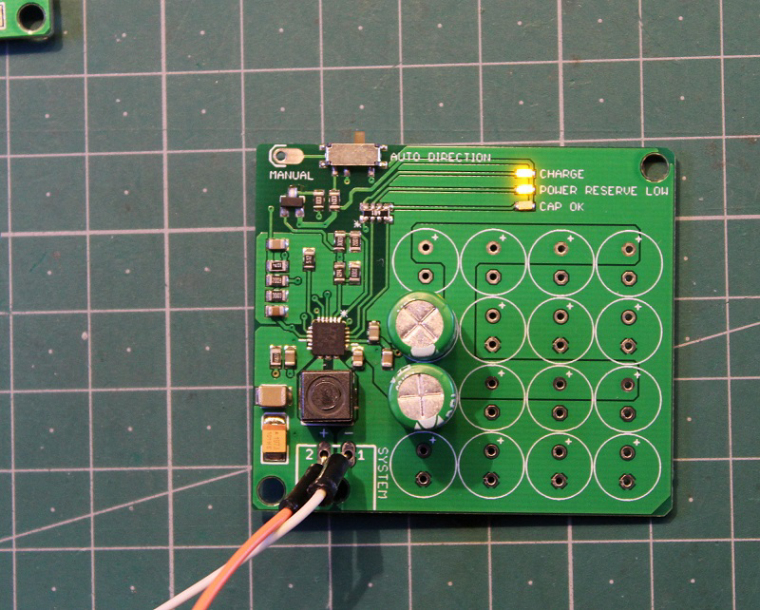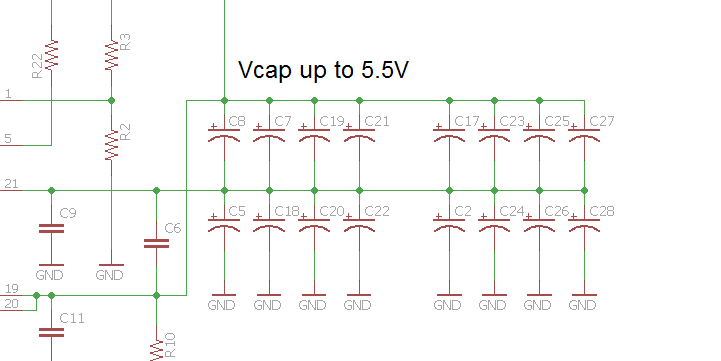How best to find the "best" small solar panel of a particular size?
-
Anyone interested in super capacitors.
I'm working on a backup super capacitor storage board. It connects directly to the power rail and charges and balances super capacitors bank. When and if power fails the board steps in and provides power to the circuit.

It is based on LTC3110 super capacitor bi-directional charging IC. -
Anyone interested in super capacitors.
I'm working on a backup super capacitor storage board. It connects directly to the power rail and charges and balances super capacitors bank. When and if power fails the board steps in and provides power to the circuit.

It is based on LTC3110 super capacitor bi-directional charging IC. -
Anyone interested in super capacitors.
I'm working on a backup super capacitor storage board. It connects directly to the power rail and charges and balances super capacitors bank. When and if power fails the board steps in and provides power to the circuit.

It is based on LTC3110 super capacitor bi-directional charging IC.@ceech
Isn't it more economic to buy just one much larger supercap, with say 16x the Farads of the supercaps in your photo? Or does a capacitor bank have some other advantages besides just higher Farads?By the way, have you found supercaps that you like which also have very low self-discharge? I've been using leakage as a proxy for self-discharge--because self-discharge data is hard to come by--but they are actually defined differently.
-
why use supercaps on an arduino tha consumes so low current? that caps will not discharge during night,when solar panels are not producing energy.?

@Tmaster They will slowly discharge. And depending on quality discharge times can vary a lot. The ones I'm using have a leaking current of 6uA.
Of course not always is a super capacitor a suitable replacement for a battery but where batteries are not available, suitable or safe, super capacitors can take their place. They also have some advantages - high cycle life of more than 100.000 cycles comes to mind. -
@ceech
Isn't it more economic to buy just one much larger supercap, with say 16x the Farads of the supercaps in your photo? Or does a capacitor bank have some other advantages besides just higher Farads?By the way, have you found supercaps that you like which also have very low self-discharge? I've been using leakage as a proxy for self-discharge--because self-discharge data is hard to come by--but they are actually defined differently.
@NeverDie Not necessarily. Larger super capacitors tend to be more expensive than smaller ones. Anyway, the board on the photo is a proof of concept. I would like to see how balancing and bi-directional charging/discharging work. Besides, I have some super capacitors left from other projects.
-
If you could make one the smallest as possible just for 2 supercaps, it would be a nice thing to have to integrate into an existing project to give it a little backup power.
@gohan said in How best to find the "best" small solar panel of a particular size?:
If you could make one the smallest as possible just for 2 supercaps, it would be a nice thing to have to integrate into an existing project to give it a little backup power.
But I'm guessing you want them in series, not parallel. Am I right? I suppose that might be useful actually. Ceech's seems to be parallel, though I can't say for sure whether or not it connects two banks of parallel caps in a series configuration or a parallel configuration.
@Ceech What voltage does it supply? Are they 2.7v supercaps, or something else?
-
@gohan said in How best to find the "best" small solar panel of a particular size?:
If you could make one the smallest as possible just for 2 supercaps, it would be a nice thing to have to integrate into an existing project to give it a little backup power.
But I'm guessing you want them in series, not parallel. Am I right? I suppose that might be useful actually. Ceech's seems to be parallel, though I can't say for sure whether or not it connects two banks of parallel caps in a series configuration or a parallel configuration.
@Ceech What voltage does it supply? Are they 2.7v supercaps, or something else?
You know what would be interesting? A capacitor bank that accepts charge in parallel but gives it back in series after a voltage threshold has been reached. That way you could charge it with very weak voltage (e.g. from a solar panel in very weak light), and still get a useable voltage out of it without the huge efficiency losses you usually get from a boost converter running at very low currents. Of course, the ESR might be very high (since it adds) if it wasn't very low in the supercaps to begin with. Low ESR supercaps are certainly available though.
@Ceech What do you think?
-
You know what would be interesting? A capacitor bank that accepts charge in parallel but gives it back in series after a voltage threshold has been reached. That way you could charge it with very weak voltage (e.g. from a solar panel in very weak light), and still get a useable voltage out of it without the huge efficiency losses you usually get from a boost converter running at very low currents. Of course, the ESR might be very high (since it adds) if it wasn't very low in the supercaps to begin with. Low ESR supercaps are certainly available though.
@Ceech What do you think?
@NeverDie you mean a like battery from a hybrid car? Cells form a pack, but monitored(at least) and [possibly] charged individually. I believe that is how they are set up. It might be a way to find a reference on how to do it.
-
This is the capacitors schematic:

Two caps are in series, pairs in parallel. IC only allows for up to 5.5V. But voltages can be set - charge voltage, backup voltage, trip voltage and charge current can all be set. @NeverDie There is a solder jumper pad on the board for low current efficiency selection. Some other DC-DC converters also have this option. -
@NeverDie you mean a like battery from a hybrid car? Cells form a pack, but monitored(at least) and [possibly] charged individually. I believe that is how they are set up. It might be a way to find a reference on how to do it.
Charge pumps work on this principle. It's just that they dump their higher voltage from the series configuration into another capacitor, whose voltage eventually rises to the series voltage. I guess that could work too, but you need switches which switch at very low voltages to pull it off if you're starting from a cold-start and, say, a solar panel is only providing you with extremely low voltage. I'm not sure how far below 0.6v you can find switches that still function. Same for the oscillator that typically drives a charge pump. That's why Ceech's board (that I linked earlier above) that works with a startup voltage of as low as 20mv (?) is so impressive. Or is that its lowest operating voltage, and it still requires a higher start-up voltage? I guess I should read the chip spec sheet.
-
Charge pumps work on this principle. It's just that they dump their higher voltage from the series configuration into another capacitor, whose voltage eventually rises to the series voltage. I guess that could work too, but you need switches which switch at very low voltages to pull it off if you're starting from a cold-start and, say, a solar panel is only providing you with extremely low voltage. I'm not sure how far below 0.6v you can find switches that still function. Same for the oscillator that typically drives a charge pump. That's why Ceech's board (that I linked earlier above) that works with a startup voltage of as low as 20mv (?) is so impressive. Or is that its lowest operating voltage, and it still requires a higher start-up voltage? I guess I should read the chip spec sheet.
-
@ceech Is there a particular brand/source of supercaps that you recommend to fit your PCB? Or do they come pre-installed?
@NeverDie I like those:
http://www.mouser.com/ds/2/40/AVX-SCC-1018831.pdf
Super capacitors will be installed on boards. -
@ceech Is there a particular brand/source of supercaps that you recommend to fit your PCB? Or do they come pre-installed?
